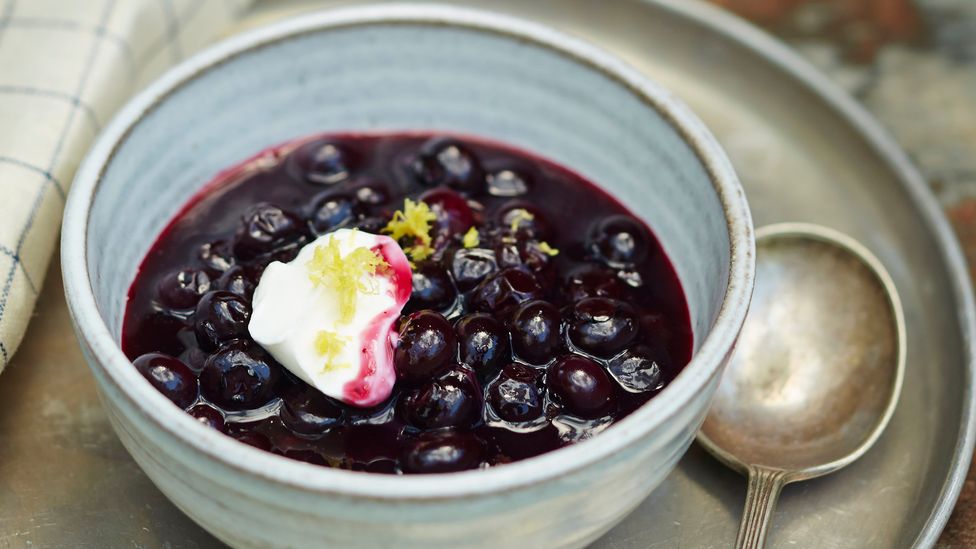About an hour has gone by: time to take the gefilte fish and carrots out of the boiling water. In another pot, I've got potatoes and pickles simmering in stock and brine; I stir in a hefty dollop of sour cream to cut the acidity and top the soup with a sprinkling of fresh chopped dill. Tomorrow, I'll be cooking a leek frittata for breakfast and schnitzel breaded with matzo meal for dinner.
I'm swimming in shtetl nostalgia – Ashkenazi Jews have been making versions of these recipes for decades. Gefilte fish (an appetiser made from poached fish), for example, has been a favorite since they first settled on the banks of the German Rhine in the 11th Century.
But there's a key difference. I'm making vegetarian versions of these dishes. And, in doing so, I know I'm closer to the traditions of my ancestors than I would be with the stacked pastrami sandwiches that have become the standard-bearer of Ashkenazi Jewish cuisine.
For my Ashkenazi ancestors, the towers of meat you can find at the Jewish deli were nonexistent. Instead, their kitchens would be full of fresh, regional and seasonal vegetables, an assortment of pickles and, if they were lucky, some dairy. Meat and fish were expensive rarities until the industrialization of meat production in the early 20th Century. That's why the gefilte fish I'm making now is a vegetarian imitation adapted from a century-old recipe using a purée of salsify (oyster plant), cashews and onion mixed with eggs and matzo meal, shaped into disc-like quenelles for poaching, then topped with one sliced ??carrot and sinus-clearing horseradish.
Instead of veal, the schnitzel is a cut of celeriac root covered in flour, egg wash and matzo meal that browns after a few minutes on a hot skillet – as instructed by an 84-year-old recipe.
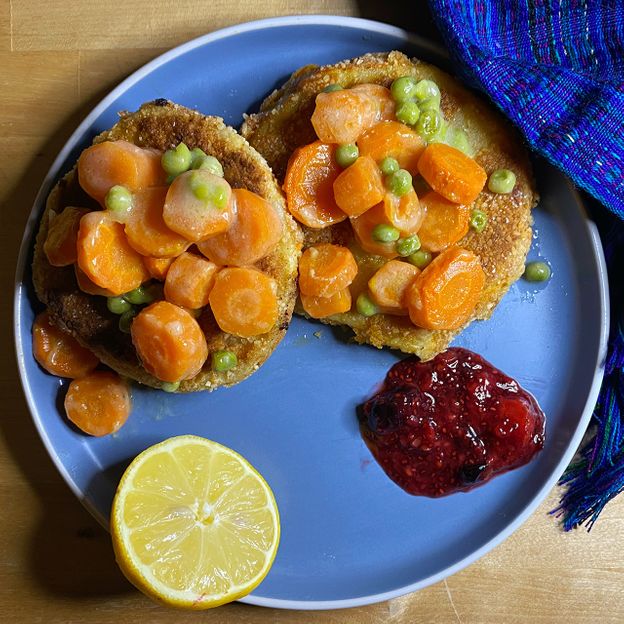
Instead of veal, this schnitzel is made of celeriac root and matzo meal (Credit: Joe Baur)
It may come as a surprise to fans of the Jewish deli, but the values ??of vegetarianism have long been espoused and cherished by Ashkenazi Jewish cooks. And these values ??are returning from the sides. From Los Angeles, California and Cleveland, Ohio, to New York's Lower East Side and Brooklyn – where most Ashkenazi Jewish immigrants first settled and many sold pickles from pushcarts – a new generation of Jewish sandwich slingers and cookbook authors are promoting "plant-forward". eating.
In doing so, they're embodying many of the beliefs spelled out by the likes of chef Fania Lewando in her 1938 cookbook The Vilna Vegetarian – and revolutionizing modern Ashkenazi Jewish cuisine by taking it back to its roots (pun intended).
The Vilna Vegetarian
Eve Jochnowitz is a culinary ethnographer based in New York City's Greenwich Village where she grew up. She published a translation of Lewando's Yiddish-language cookbook in 2015, including around 400 vegetarian recipes.
There are sections expected of most any cookbook, like salads – with earthy dishes based on radishes and red cabbage – and soups ranging from a puréed carrot soup to bran borscht. Then come the unmistakably Jewish sections, like latkes (10 kinds) and Passover foods. There is even a section labeled "Kugels with Cholents", with 11 different ways to make the traditional Jewish casserole to go with the Sabbath stew left to simmer overnight – that way, it's ready for Shabbat lunch without lifting a finger.
In the foreword to The Vilna Vegetarian, celebrated cookbook author Joan Nathan writes that the Yiddish and German kosher cookbooks of the 1930s offered vegetarian recipes in response to anti-Semitic laws outlawing the traditional Jewish ritual of slaughtering animals. But vegetarianism in Jewish cuisine goes back as far as the Talmud, the compilation of rabbinic debate on Jewish law, philosophy and biblical interpretation that was produced between the 3rd and 8th Centuries.
Nora Rubel is co-founder of the vegan Jewish deli Grass Fed in Rochester, New York, and a Jewish studies professor at Rochester University where she researches American Jewish culture, culinary history and religion. She noted that the Talmud allows for the use of a beet on a Passover Seder plate instead of a shank bone. Knowledge like this, Rubel said, can embolden Jewish vegetarians.
"This shows us that [our ancestors] were already talking about this a long time ago," Rubel said. "This is part of our culinary lineage."
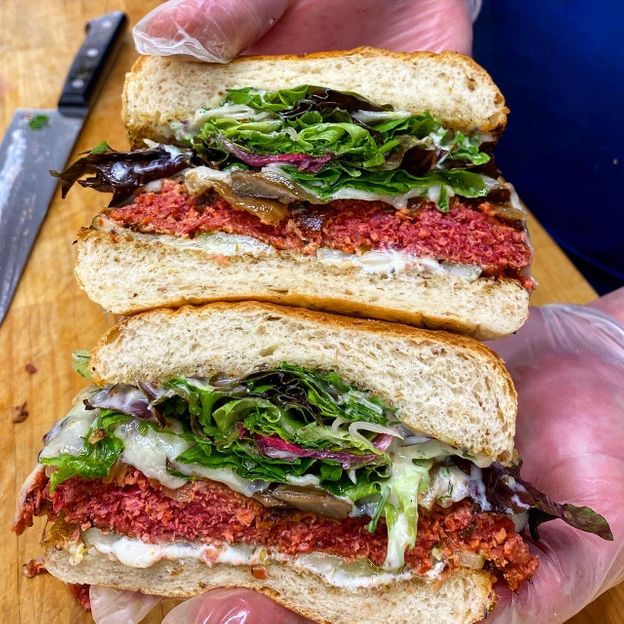
Plant-forward takes on Jewish food – like this vegan burger from the Cleveland, Ohio deli Larder – may seem like a modern trend, but go back centuries (Credit: Jeremy Umansky)
Centuries later, in 1938, Lewando continued that lineage in what is today Vilnius, Lithuania, where she owned a kosher dairy restaurant, ran a kosher cooking school and supervised a vegetarian kosher kitchen on an ocean liner that traveled between Gydnia, Poland, and New. York City. In the introduction to her cookbook, she wrote of the importance of being resourceful and never throwing anything away because "everything can be made into food".
She also connected vegetarianism to Jewish values.
"From the humanitarian principle of 'tsar baaley khayim' (not killing living creatures), it would be desirable to replace meat with a purely vegetarian cuisine," Lewando wrote.
Land of abundance
What happened between the 1930s and today? After all, salads full of garden vegetables and resourceful soups are hardly what come to mind when people think of Ashkenazi Jewish food.
"Meat was super cheap in America," said Jeffrey Yoskowitz, Jewish food expert and the co-founder of Papaya , a plant-based food delivery platform featuring meals from top chefs at vegan and non-vegan restaurants. "The idea of ??eating this giant mega sandwich of beef is just the ultimate symbol of abundance and the affluence of America."
In fact, that abundance made not eating meat a mockable offence, said Jochnowitz. "There is a Yiddish saying: 'Dos beste milkhiks iz a shtikl fleysh'," she said. "The best dairy is a piece of meat."
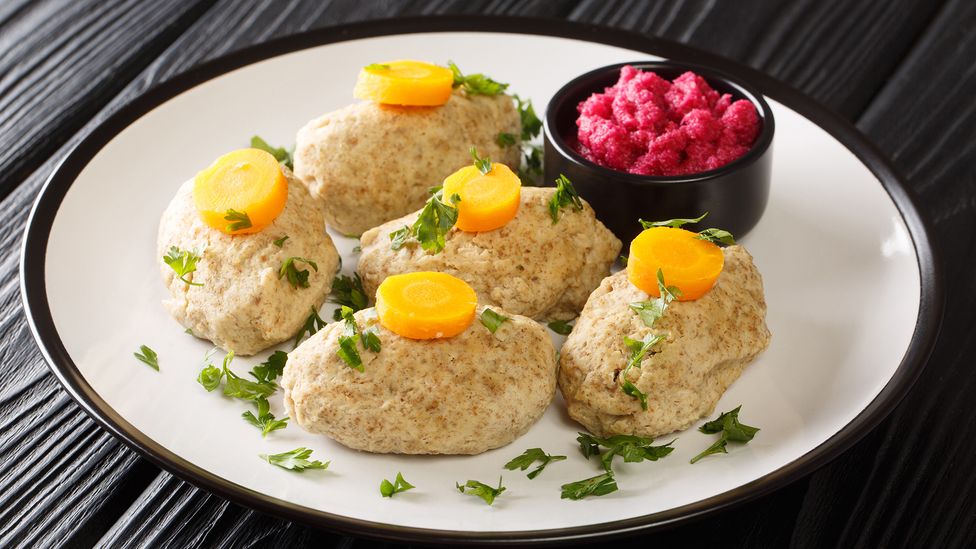
When Ashkenazi Jews immigrated to the US, eating real meat and fish – like gefilte fish – was a sign of abundance (Credit: Alleko/Getty Images)
In reality, eating meat on rare occasions was the norm throughout Ashkenazi Jewish history up until their arrival to the United States and the industrialization of meat that drove down prices. Before then, meat was not something most Jews in Eastern Europe could afford in the 18th, 19th and early 20th Centuries. Coupled with meat shortages and lack of access to kosher meat, most Jews were what Jochnowitz calls "de facto vegetarians", though they likely would not have thought of themselves as such.
"People look at Jewish delis as the place where you get traditional home-cooked Jewish foods, but immigrant Ashkenazi Jewish mothers didn't want children going to the deli," said Yoskowitz. "My grandmother didn't want my father going to the deli because these weren't the foods at home."
The deli meats and knishes (stuffed dough balls) of the Jewish-American deli were junk food in the eyes of Yoskowitz's Poland-born grandmother. It's no surprise his grandmother would take such a strict view considering she was herself a vegetarian. She'd take her son, Yoskowitz's father, to the Catskills in Upstate New York for a summer vacation stays at The Vegetarian Hotel, a resort founded in the early 20th Century. There was vegetarian chopped liver, blueberries with sour cream and radishes and other vegetables from the hotel garden.
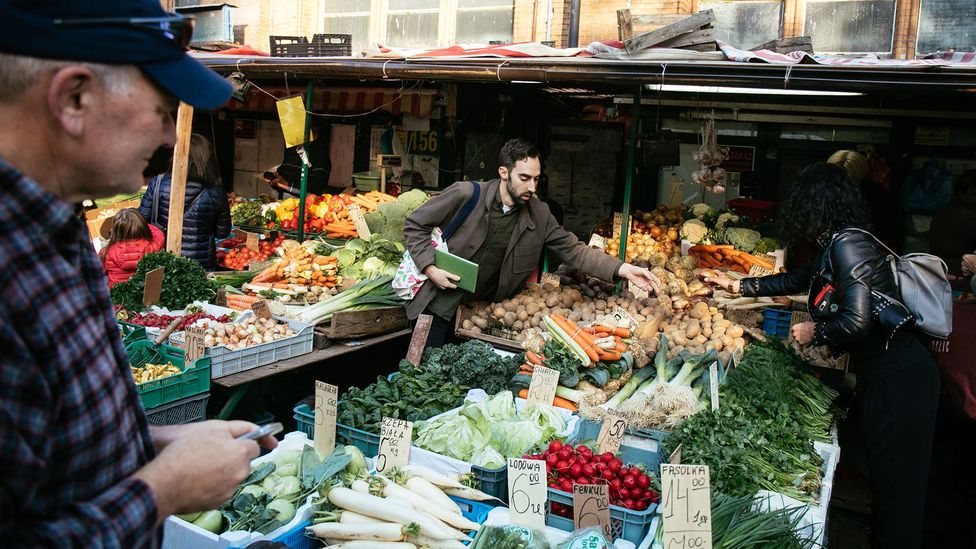
Jeffrey Yoskowitz examines the fresh produce at a Polish market (Credit: Taub Jewish Heritage Tours)
It's a story Yoskowitz touches on in his 2016 award-winning cookbook The Gefilte Manifesto, where he and his co-author Liz Alpern revisit traditional, Old World Jewish foods with new recipes. The emphasis of the book is on embracing the resourceful techniques of our Ashkenazi Jewish ancestors, such as pickling.
In fact, it was pickling that first got Yoskowitz hooked on rediscovering Ashkenazi Jewish cuisine 15 years ago, at the organic Jewish farm Adamah in Connecticut. It made him question why neither pickling nor the connection between harvests and sustainability weren't more intrinsically connected to Ashkenazi Jewish culinary history. "I felt like that story wasn't being told through the delis," he said.
Culinary nostalgia
The urge to rediscover traditional recipes might be even stronger among Ashkenazi Jews than other cultures because of the Holocaust, said Yoskowitz. The loss of their culinary homeland and the murder of so many families, he said, created a tenuous connection to the places where Ashkenazi families lived for centuries and – in some ways – froze Ashkenazi cuisine in time.
He contrasted the Jewish experience to that of Italians. While Italians also immigrated to the Lower East Side, many often would travel back and forth to their homeland, importing a number of ingredients to the US with them. Lower East Side Jews, on the other hand, only imported dried mushrooms, thanks partly to the fact that they couldn't recreate the local terroir or forest floor of their homeland in New York City. Then the Holocaust decimated the unmarked boundaries of Yiddishland that stretched from France across Central Europe to the edges of Eastern Europe; for many, the pain severed any connection they had had.
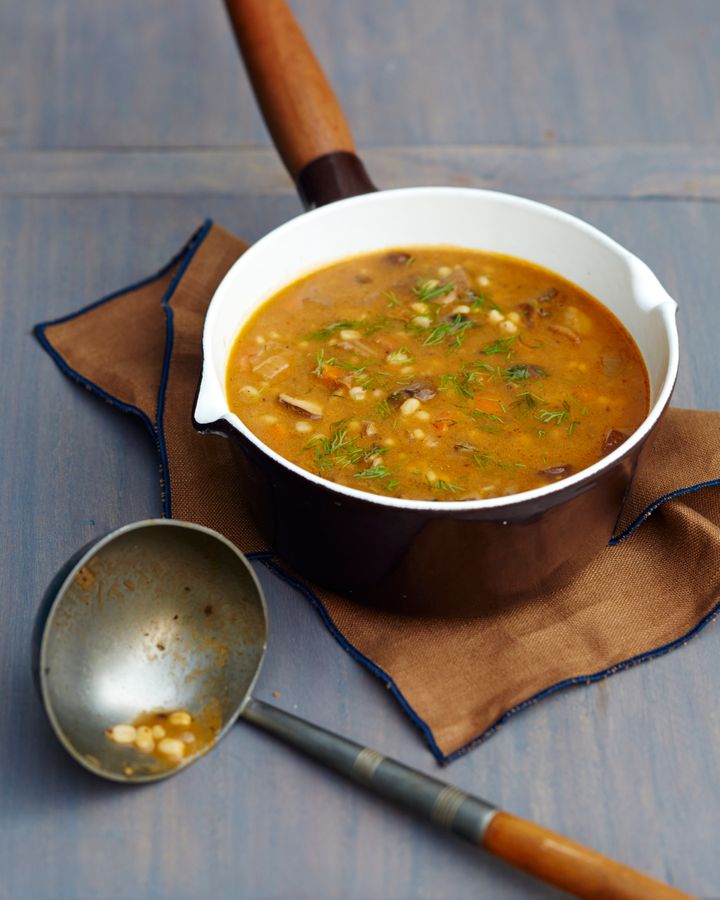
The Gefilte Manifesto’s mushroom barley soup, inspired by Fania Lewando (Credit: Lauren Volo)
"A whole new culture had to be forged," said Yoskowitz. "But because of that, the nostalgia for the past grows stronger and stronger."
So it's fitting that a number of new vegan Jewish delis pay homage to the owners' grandparents – like Ben & Esther's in Portland, Sam & Gertie's in Chicago and Mort & Betty's in Los Angeles.
The Vilna Vegetarian continues to influence her cooking, said Mort & Betty’s owner Megan Tucker. She often refers to the book for recipes or to see how a specific ingredient was used.
"I love the procedure in the pickled cucumbers recipe," Tucker said. "Scalding a barrel, covering the bottom with horseradish leaves and finishing by pounding a stopper into the top and placing it in the sun for two days."
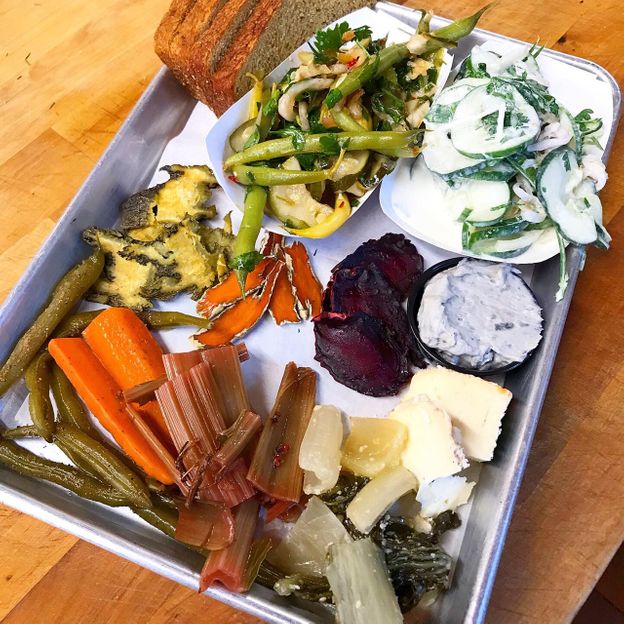
A vegetarian platter at Larder includes seasonal salads and fermented vegetables (Credit: Jeremy Umansky)
In Cleveland, Ohio, meanwhile, a refurbished mid-19th Century firehouse has become a haven of nostalgic aromas and spices. Larder Delicatessen and Bakery chef Jeremy Umansky also credits The Vilna Vegetarian for showing him how his ancestors truly would have eaten, using plants first and meat only on special occasions.
Umansky, too, is fascinated by pickling. He uses koji, a Japanese mould that speeds up the curing process and gives vegetables a smoky, savoury flavour with a texture that resembles meat. (In 2020, he even co-authored the book Koji Alchemy: Rediscovering the Magic of Mold-Based Fermentation.) Koji is an essential ingredient to his vegan pastrami, which features mushrooms that are cured with salt before being spiced and smoked.
Nobody can say for certain where Ashkenazi Jewish cuisine is headed next. But there's no doubt it'll be far more complex and multifaceted than most deli fanatics could imagine. Fruits and vegetables from the garden will be front and centre – whether salted, seasoned, roasted or pickled.
For that, we can thank this new generation of cooks who are circling back and taking their cues from the seeds planted by our ancestors. Whatever the result, it will be delicious.


 jamessprag
jamessprag
